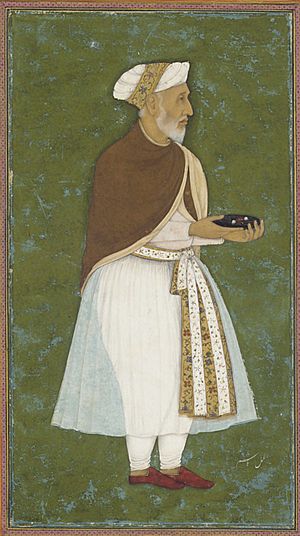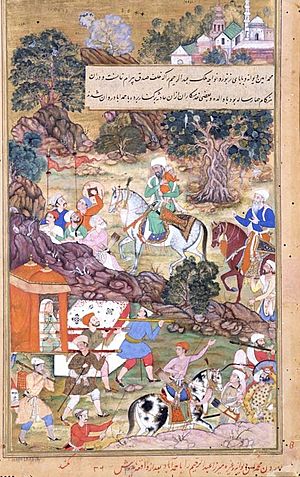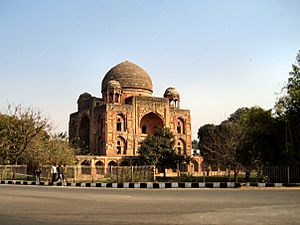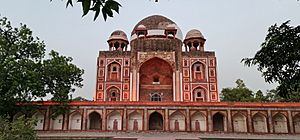Abdul Rahim Khan-i-Khanan facts for kids
Quick facts for kids
Abdul Rahim
|
|
|---|---|

A portrait of Abdul Rahim Khan-i Khanan by Hashim, around 1627.
|
|
| Born | 17 December 1556 |
| Died | 1 October 1627 (aged 70) |
| Resting place | Tomb of Abdul Rahim Khan-i-Khanan, Delhi |
| Title | Khan-i-Khanan |
| Spouse(s) | Mah Banu Begum |
| Children |
|
| Parents |
|
Khanzada Mirza Khan Abdul Rahim (born December 17, 1556 – died October 1, 1627), often called simply Rahim, was a famous poet and general. He lived in India during the time of the Mughal Empire. He was a close friend and mentor to Emperor Akbar. Rahim was one of the nine important advisors, known as the Navaratnas (Nine Gems), in Akbar's court. He was well-known for his short poems called dohe (couplets) and his books about astrology. He held the special title of Khan-i-Khanan, which means "Khan of Khans" or "General of Generals".
Contents
Biography

Abdul Rahim was born in Delhi. His father was Bairam Khan, who was a trusted guardian and advisor to Emperor Akbar. Bairam Khan came from a Turkic family.
When Emperor Humayun (Akbar's father) returned to India, he asked his nobles to marry into important families across the country. Humayun himself married the elder daughter of Khanzada Jamal Khan of Mewat. He also asked Bairam Khan to marry Jamal Khan's younger daughter.
The Khanzadas were a royal family of Muslim Rajputs. They were important chiefs in the Mewat State region.
After Bairam Khan was killed in Patan, Gujarat, his wife and young Rahim were safely brought to Akbar's royal court in Ahmedabad. Akbar gave Rahim the title 'Mirza Khan'. Later, Akbar arranged for Rahim to marry Mah Banu, who was the sister of Mirza Aziz Kokah, another important Mughal noble.
Rahim's stepmother, Salima Sultan Begum (Bairam Khan's second wife), later married her cousin, Emperor Akbar. This made Abdul Rahim Khan-i-Khan also Akbar's stepson. He then became one of Akbar's nine most important ministers, the Navaratnas. Besides being a poet, Rahim Khan was also a skilled general. He was sent to stop rebellions in Gujarat and later led military campaigns in Maharashtra.
He earned the high position and title of Khan-i-Khanan, which means "Khan of Khans".
Abdul Rahim was known for his unique way of giving to the poor. He would never look at the person he was giving alms to. He always kept his gaze downwards, showing great humility. When the famous poet Tulsidas heard about Rahim's behavior, he wrote a couplet and sent it to Rahim:
"ऐसी देनी देंन ज्यूँ, कित सीखे हो सैन
ज्यों ज्यों कर ऊंच्यो करो, त्यों त्यों निचे नैन"
This means: "Why do you give alms like this? Where did you learn that? Your hands are as high as your eyes are low."
Rahim understood that Tulsidas knew why he acted that way and was just giving him a chance to reply. So, Rahim wrote back to Tulsidas:
"देनहार कोई और है, भेजत जो दिन रैन
लोग भरम हम पर करे, तासो निचे नैन"
This means: "The Giver is someone else, who gives day and night. But people give me the credit, so I lower my eyes."
Rahim was also known for his love of Persian culture.
Campaign against Mewar
In 1580, Akbar made Rahim the chief of Ajmer. Around the same time, Akbar asked him to lead another military campaign against Maharana Pratap to capture him. Rahim set up his family in a place called Sherpura and then moved his army towards Mewar. Maharana Pratap positioned his forces in a hilly pass to block the Mughal army.
Meanwhile, Pratap's son, Prince Amar Singh, attacked Sherpura. He managed to capture the women of Rahim's family and brought them to Mewar. However, Maharana Pratap was very upset with his son for capturing women. He ordered Prince Amar Singh to return them to Rahim with full respect and honor.
Major works
Rahim wrote many dohas (couplets). He also translated Babar's life story, Baburnama, from the Chagatai language into Persian. He finished this translation in 1589–90. Rahim was also very good at the Sanskrit language.
In Sanskrit, he wrote two books about astrology. Their names are Khetakautukam (खेटकौतुकम्) and Dwatrimshadyogavali (द्वात्रिंशद्योगावली).
Tomb

Rahim's tomb is located in Nizamuddin East in Delhi, near Humayun's Tomb. He built this tomb for his wife in 1598. When he passed away in 1627, his body was also placed there.
Later, in 1753–54, some of the marble and sandstone from Rahim's tomb was used to build Safdarjung's Tomb, which is also in New Delhi.
In 2014, the InterGlobe Foundation and the Aga Khan Trust for Culture started a project to preserve and restore Abdul Rahim Khan-i-Khanan's tomb.
The tomb is a very noticeable landmark along the Mathura Road, which was once the Mughal Grand Trunk Road. It is also close to the Dargah of Nizamuddin Auliya and Humayun's Tomb. In 2020, after six years of restoration work by the Aga Khan Trust for Culture, Rahim Khan's tomb was opened to the public. This was one of the biggest conservation projects ever done on an important historical monument in India. Because of its beautiful architecture and purpose, it is often compared to the Taj Mahal.


